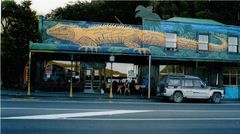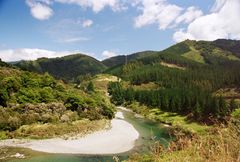Picton to Nelson #

Although the total distance to Nelson is only 109 kilometres, the road rises over two considerable saddles, the Rai Saddle (220 metres) and the Whangamoa Saddle (400 metres). Consequently many cyclists break this into a two day trip. Most choose to cycle directly from the ferry to Havelock (35 km from Picton, campground, backpackers, supermarket & mail), or continue on to Pelorus Bridge (around 55 km from Picton, campground, cabins, tearooms, no store).
Just past the Rai Valley (store, pub, no campground) you can turn right over the bridge down a side road and camp by the stream if you are unobtrusive and tidy. One memorable night I was woken here by two stray dogs that had come tearing out of the hills attracted by the scent of my unwashed saucepans. It was a bit of a scare but they took off after a couple of yells. However, it was not the most pleasant way to wake up in the early hours. Remember to take insect repellent to fend off midges.
From Havelock to the Rai Valley the road is easygoing and generally flat or mildly undulating. From Rai Valley however, it begins to climb toward the first saddle. Be aware that there is no store between the Rai Valley and Nelson.
The scenery between Picton and Nelson is magnificent. The Marlborough Sounds curve out into broad expanses of blue/green water studded with islands and maintain brilliant views to your right most of the way to Havelock and beyond. Once you pass the Rai Valley and start climbing the saddles you can look back down steeply sided valleys of bush and pine forests. Breathe the air... welcome to the South Island.
On a fine day this is what cycling is all about. If you find the second saddle difficult, don't be afraid to get off and walk and stop at the wide curves of the road and look back into the valleys occasionally, or muse at the wild hills to your left, or sigh a bit at the road winding up ahead of you. Even walking, the saddles only take two or three hours to get over. And then you have the glorious downhill stretch from the top of the Whangamoa. Ten kilometres of, winding descent over rushing streams with glimpses of rivers in the deep valleys to your left. This is exhilarating cycling. At the bottom there are still another fourteen kilometres to cover but this is generally straightforward and the last few kilometres into Nelson are flat with the serene, blue Tasman Bay on your right.
Nelson is a substantially large town in a beautiful setting. There are plenty of campgrounds, backpackers, bike shops, cafés etc. Nelson is a popular place for overseas travellers to either settle or base themselves. It has a strong mix of environmental concerns and arts and crafts. It welcomes cyclists, is one of the few New Zealand towns with a series of accessible bike paths, and offers a range of choices of what to do next. Many book to tramp the Heaphy Track, or plan to head down the central roads south via the beautiful Lewis Pass to Christchurch. But most want to meander a bit further west first. Toward Motueka, Tākaka and Collingwood.

